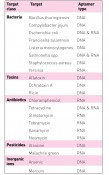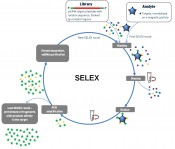Aptamers as a new alternative to antibodies
Within the European Union, measures to safeguard our food are becoming increasingly stringent: any constituents hazardous to health are either prohibited or permitted only as a trace. For analytics, ensuring compliance and monitoring for all of the statutory provisions safeguarding our food is a hugely challenging task. While immunotests have now been deployed successfully in rapid testing for the last three decades, aptamers have demonstrated increasing potential as a new alternative to antibodies in recent years.

Driven by the high standards demanded by food manufacturers and regulatory authorities, food analytics is pushing into the realms of ever-smaller concentrations: the reliable detection of trace amounts of antibiotics, mycotoxins, pesticides, allergens, hormones and other undesirable substances is already mandatory. In satisfying these requirements, analytics pursues two separate strategies. The first is to deploy high-end methods for trace detection: modern LC-MS applications form the most obvious example of this approach. While these methods represent the peak of sensitivity, they also have an undeniable disadvantage: since the equipment required is extremely expensive and must be operated by specially-trained personnel, this effectively rules out true on-site testing. While samples for analysis are taken on-site, the actual analytical procedures are performed in an appropriately-equipped laboratory.
The rise of rapid tests
To overcome this obstacle, rapid tests have seen increasing deployment over the last few years. These simple test kits are easy to use, very cost-effective and can be performed in a minimally-equipped laboratory or sometimes even carried out on-site. While sensitivity is generally inferior to that of the reference methods, it is still adequate to comply with legal requirements. To develop rapid tests, a common approach is to exploit biomolecules that have the ability to detect a certain target molecule specifically. Antibodies offer the most familiar example of molecules that have highly specific binding properties. Originating in the first immunotests deployed for medical applications, a set of antibody-based rapid tests now dominates application areas throughout analytics. Over the last few decades, rapid immunotests ranging from small molecule and protein testing through to the detection of viruses and microorganisms have been developed and launched on the market. The test delivery systems are generally as varied as the range of molecules targeted. The simplest systems, mostly designed for qualitative analysis, are lateral flow devices (LFDs) or “test strips”. Enzyme Linked Immunosorbent Assays (ELISAs) are capable of very high levels of quantification, while modern biosensors produced in recent years represent the cutting edge of immunotest development.
DNA and RNA aptamers as an alternative to antibodies
For a little over a decade, the volume of articles published about aptamers as a new alternative to well-established antibodies has continued to rise. The term “aptamer” is derived from the Latin word “aptus” (= suitable) and the Greek word “meros” (= part) and illustrates the “lock-and-key” relationship between aptamers and their binding partners. Molecules deployed as aptamers are short nucleic acid fragments: either RNA or single-stranded DNA. Their special three-dimensional structure is responsible for their specificity and affinity for a target molecule. The actual binding to the target is effected by a combination of the steric properties, in association with reciprocal electrostatic effects and hydrogen bridge bonds. The procedure deployed for deriving aptamers for a specific target molecule is termed SELEX. SELEX is short for Systematic Evolution of Ligands by Exponential Enrichment and designates the targeted in-vitro evolution of aptamer candidates to derive optimal binding partners. The starting-point for this procedure is a random library of single-stranded nucleic acids. As a rule of thumb, this library should contain no less than 1014 separate combinations of the four bases. On account of the many options for structural formation, this approach should therefore yield a matching nucleic acid fragment for almost any target molecule. This random sequence is flanked by a constant region at its 5?- and 3?-ends, which later serves as the binding site for PCR primers. This nucleic acid library is then brought into contact with the immobilised target on the carrier medium. This “fishes out” all of the library fragments capable of binding more or less well to the target. These interacting fragments are then multiplied using a PCR procedure on the constant region and subjected to a further round of selection. This process is repeated until the only fragments remaining are the ones that bind most tightly.
To date, the SELEX procedure has now synthesised aptamers matching almost every kind of analyte: bacteria and viruses, polysaccharides, proteins, small molecule substances – even atoms do not present a problem. Since aptamers are enriched in vitro, even highly toxic targets – for which antibody production is a non-trivial procedure – present no difficulties. Two online databases [1, 2] provide the ability to search for previously-discovered aptamers. They provide details of the nucleic acid sequence and offer additional information about the SELEX procedure parameters and association-rate constants for each of the binding partners.
Outstanding selectors
Compared to antibodies, aptamers have a number of advantages, although these are tempered by limitations. In terms of sensitivity, antibodies and aptamers occupy very similar ranges of values, notwithstanding the fact that the maturity of immunoassay technology makes the latter preferable for detecting very low concentrations. Aptamers have the major advantage of offering outstanding selectivity, however: since the nucleic acid fragments are matched to their target during a complex process of in vitro evolution, undesirable cross-reactions can be virtually excluded. The option of applying the counter-selection technique during the SELEX procedure enables the active exclusion of aptamer candidates with undesirable binding properties from the fragment pool. Just over a decade ago, when aptamer development was still in its infancy, RNA aptamers were a common deployment option. While RNA’s multitude of folding options offers substantial benefits when compared to DNA, a high price is paid for this advantage – in the form of substandard stability. In practical terms, however, it is precisely the insensitivity of DNA aptamers to external factors that constitutes their major benefit. DNA is a highly stable biomolecule, capable of surviving unscathed even after exposure to heat, cold, atypical pH environments and high salt concentrations. Hopes for a bright future for aptamers rest precisely on this stability. Even prolonged storage is unable to substantially weaken aptamer activity. Aptamers also offer a further key benefit: they can be synthesised at short notice, both simply and inexpensively. Once its sequence is known, a structurally identical aptamer can be obtained commercially from any manufacturer of oligonucleotides. This not only eliminates batch-to-batch variations resulting from immunisations but also avoids the need to use animal subjects for antibody harvesting.
Aptamers have been used to develop test formats similar to the forms long since typically used in immunoassays. It is a very simple matter to conjugate aptamers covalently to colloidal gold particles. Such functionalised gold particles have now been developed into a wide range of LFDs for rapid qualitative analysis. A test format essentially reproducing the ELISA technique is also available for quantitative testing. This format, known as an Enzyme Linked Aptamer Assay (ELAA), involves the deployment of an immobilised capture aptamer to “fish” an analyte out of a sample, whilst a second, enzyme-conjugated detection aptamer is deployed as a catalyst for a colour reaction. Since DNA fragments exhibit much simpler and much more widespread surface binding properties than antibodies, this approach opens up a broad spectrum of possible applications for biosensors. Antibodies generally bind to surfaces only via adsorption, whereas aptamer conjugation is generally covalent. The strength of covalent bonds permits the simple regeneration of biosensors. After binding, the analyte can simply be rinsed off the surface of the sensor – even under the harshest environmental conditions.
All of the test formats described above have already seen deployment in food safety detection procedures. Here, aptamers have established themselves in two quite separate disciplines, namely: confirming the presence of pathogens in food and the detection of toxic substances. Table 1 gives an overview of the aptamers developed to date for use in food analytics.
SELEX – the artificial evolution of aptamers
Aptamers are manufactured using the SELEX procedure. This process involves the iterative improvement of DNA or RNA fragment matching to the target. All SELEX variants share a common starting-point: a library of nucleic acids with random base sequences. The method used for further selection of the highest-affinity fragments can then vary considerably, however. The FluMag-SELEX procedure (Fig. 1) has proved itself to be a particularly uncomplicated and flexible approach, and is now the most widely-available option for generating aptamers for specific analytes.
With this method, the target to which aptamers should bind is immobilised on the surface of magnetised particles. Once functionalised, the particles are then combined with the nucleic acid library and fragments with affinity then bind to the target. A magnet can now be used to separate and rinse off the particles with the first round of candidates. In the next step, the handful of fragments so isolated can be multiplied using PCR and the two strands separated. While we now once again have single-stranded nucleic acids, only those candidates from the initial library with target affinity now remain. The next SELEX round is now started: this time, more stringent conditions are imposed, so as to force further adaptation of potential aptamers to the target. Multiple iterations of this procedure are used until the remaining aptamers all show exceptional binding to the analyte. The last surviving fragments are cloned using plasmids and sequenced.
Fig. 1 Overview of the FluMag-SELEX procedure. In recent years, this particular SELEX method has prevailed against other variants, since most targets can be very easily coupled to magnetic particles. Separation of the bound nucleic acid fragments simply requires the use of a permanent magnet.
The future of aptamers
While many aptamers with the potential for use in foodstuff analysis have been developed to date, commercial exploitation is still a rare occurrence. Since aptamer technology trails immunotest development by about a couple of decades, the key application areas for rapid tests are already occupied by antibody-based detection systems exhibiting a very high degree of optimisation. While aptamer tests must often contend with teething troubles – a frequent criticism is their relative fragility – this class of molecules still offers more development potential than any other technology for the next few years. The unique properties of these nucleic acid fragments benefit the burgeoning field of sensor technology in particular. No other biomolecule can be modified so simply in order to bind it to sensor surfaces – nor at such a low price point. In addition, the stability offered by DNA vis-à-vis external factors permits the regeneration – and hence multiple use – of sensors. The challenge for both researchers and commercial stakeholders is to further improve the wide range of test formats for known and newly-discovered aptamers, while also focusing in particular on robustness for real-world applications.

Fig. 2 Overview of aptamers developed to date and their corresponding test systems. - Other details of these aptamers, including their sequences and original literature, can be obtained by consulting the aptamer databases [1, 2].
Bibliography:
[1] �The Ellington Lab Aptamer Database: http://aptamer.icmb.utexas.edu
[2] �Aptamer Base: http://aptamer.freebase.com/
Photo: ©istockphoto.com?|?StudioThreeDots
|

















